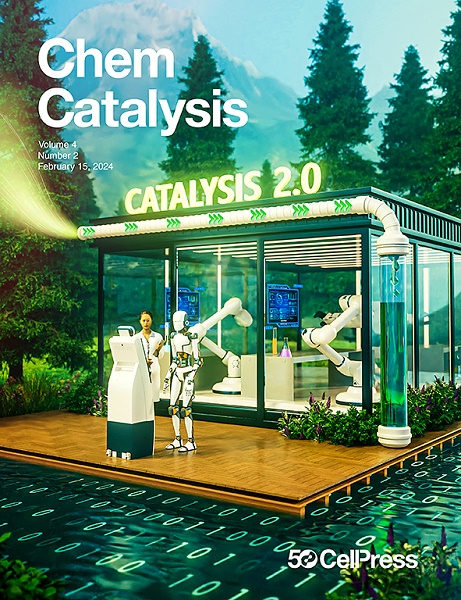Upcycling CO2 into succinic acid (C4H6O4) by cascading CO2 electroreduction with electrocarboxylation
IF 11.6
Q1 CHEMISTRY, PHYSICAL
引用次数: 0
Abstract
Extending carbon dioxide (CO2) electrocatalysis to afford energy-rich carbohydrates with long carbon chains is significant but still suffers from unsatisfactory selectivity for products with more than three carbon atoms. Here, using CO2 as the only carbon feedstock, we present a cascade electrolysis strategy for succinic acid (SA; C4H6O4) synthesis by coupling CO2 electroreduction with electrocarboxylation of in situ-generated ethylene (C2H4). An overall CO2-to-C4H6O4 conversion was achieved. Our findings illustrate that adsorption of in situ-generated C2H4 and the rate-determining step (∗C2H4 to ∗C2H4COO) occur more easily over FeNi foam. Notably, compared with typical CO2 reduction products, converting gaseous CO2 into SA lowers separation costs, enhancing economic viability. Our strategy also significantly reduces carbon emissions (−0.174 kg CO2 per kg SA), compared with conventional strategies (1.94 for petrochemical and 0.88 for bio-based SA). This system accelerates CO2 conversion into long-chain carbohydrates, facilitating reintegration of this industrial waste gas into the global economy.

通过级联CO2电还原和电羧化将CO2升级为琥珀酸(C4H6O4)
将二氧化碳(CO2)电催化作用扩展到提供具有长碳链的高能量碳水化合物是很重要的,但对于含有三个以上碳原子的产物的选择性仍然不令人满意。在这里,使用二氧化碳作为唯一的碳原料,我们提出了琥珀酸(SA;用CO2电还原与原位乙烯(C2H4)电羧化偶联法合成C4H6O4。实现了co2到c4h6o4的整体转化。我们的研究结果表明,在FeNi泡沫上更容易吸附原位生成的C2H4和速率决定步骤(∗C2H4到∗C2H4COO)。值得注意的是,与典型的CO2还原产品相比,将气态CO2转化为SA降低了分离成本,提高了经济可行性。我们的策略还显著减少了碳排放(- 0.174 kg CO2 / kg SA),而传统策略(石化为1.94 kg,生物基SA为0.88 kg)。该系统加速二氧化碳转化为长链碳水化合物,促进这种工业废气重新融入全球经济。
本文章由计算机程序翻译,如有差异,请以英文原文为准。
求助全文
约1分钟内获得全文
求助全文
来源期刊
CiteScore
10.50
自引率
6.40%
发文量
0
期刊介绍:
Chem Catalysis is a monthly journal that publishes innovative research on fundamental and applied catalysis, providing a platform for researchers across chemistry, chemical engineering, and related fields. It serves as a premier resource for scientists and engineers in academia and industry, covering heterogeneous, homogeneous, and biocatalysis. Emphasizing transformative methods and technologies, the journal aims to advance understanding, introduce novel catalysts, and connect fundamental insights to real-world applications for societal benefit.

 求助内容:
求助内容: 应助结果提醒方式:
应助结果提醒方式:


